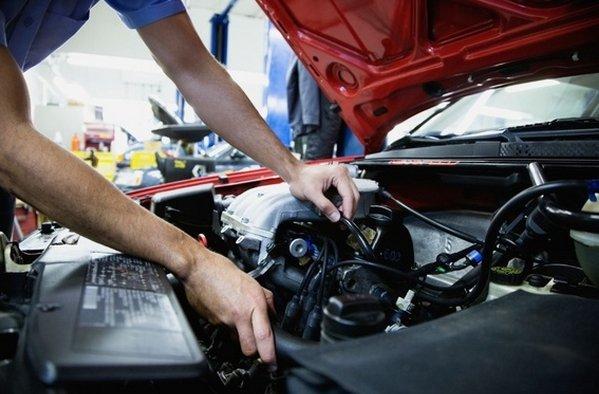
Why does the car stall on the go, then it starts and goes on
Content
If the car stalls on the go, then it starts, then the ignition system malfunction is associated with poor contact, which disappears from time to time, while all the main elements of the system are working. To check the ignition system, immediately after the engine stops spontaneously, try to start it for 20-30 seconds, and start the engine as usual.
Any experienced driver has at least once encountered a situation where the car stalls on the go, then it starts up, moreover, this did not necessarily happen with his car. Therefore, it is important for every car owner to understand why this happens and what to do in such a situation.
How the engine and fuel system work
To understand such a strange behavior of the vehicle, you need to understand how its motor functions. Regardless of the type of fuel, the principle of operation of the power unit is always the same - the air-fuel mixture flares up in the cylinders, creating high pressure due to the release of combustion products. This increased pressure pushes the piston towards the crankshaft, causing the latter to rotate in the desired direction. Consistent operation of all cylinders, as well as the heavy weight of the crankshaft and flywheel, ensure smooth operation of the motor. We analyzed these issues in more detail here (the car stalls at idle and low speeds).
The main causes of engine failure while driving
An automobile motor is a very complex unit, the operation of which is provided by various systems and devices, therefore, the cause of a spontaneous stop is almost always the failure or malfunction of additional equipment. After all, it is quite difficult to damage the parts of the engine itself, and when this happens, its work is greatly disrupted.
Out of fuel
An experienced or even just a responsible driver constantly monitors the level of fuel in the tank, so the fuel can only run out as a result of force majeure, that is, force majeure circumstances. For example, having got into a traffic jam in winter due to an accident on the highway, the driver will be forced to heat the interior due to the operation of the engine. If the reason for stopping the movement is quickly removed, then there will be enough fuel to get to the nearest gas station. However, in cases where, for various reasons, it is impossible to quickly clear the road, fuel consumption will increase dramatically and it may not be enough before refueling.
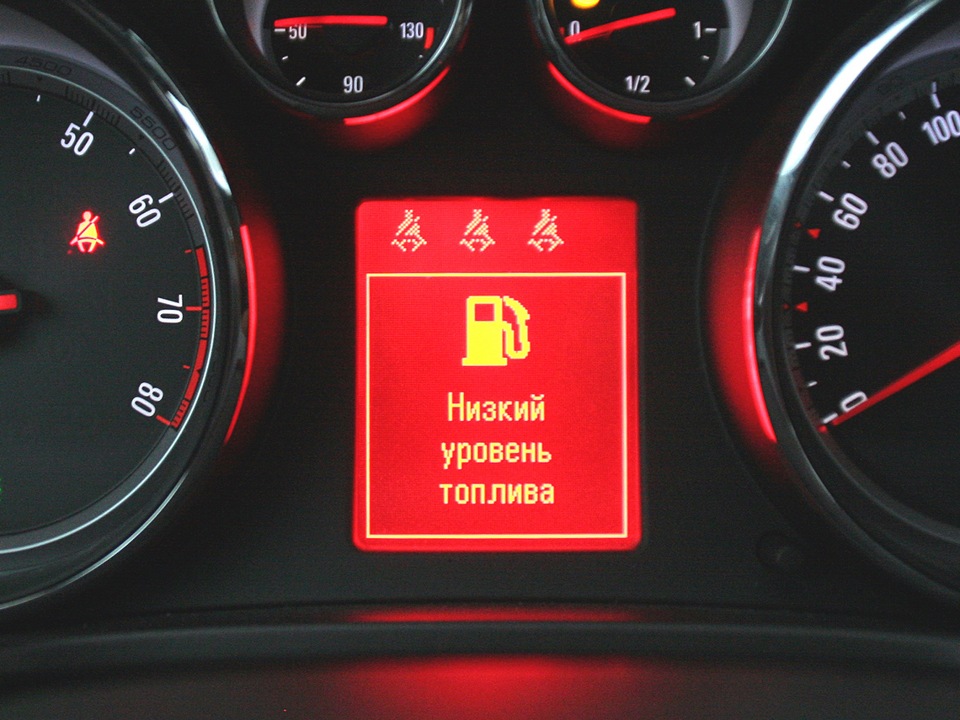
Fuel indicator in a car
Inexperienced drivers often forget to control the amount of fuel in the car, so it ends up in the most unexpected place. It is good if this happens near a gas station or a busy highway, where you can ask for help from other road users. It is worse if gasoline or other fuel runs out far from inhabited places.
The only advantage of this reason is that after refueling, it is enough to pump the fuel system (on modern cars this process is automated, but on old ones you have to pump fuel manually) and you can continue driving.
Fuel pump broken
The fuel pump supplies fuel to the carburetor or injectors, so if it fails, the engine stops. There are 2 types of such pumps:
- mechanical;
- electric.
Mechanically equipped carburetor and very outdated diesel cars, and on the first one it worked from the camshaft of the cylinder head (cylinder head), and on the second from a separate drive connecting the unit to the crankshaft pulley. Due to differences in design, the reasons for failure were also different.
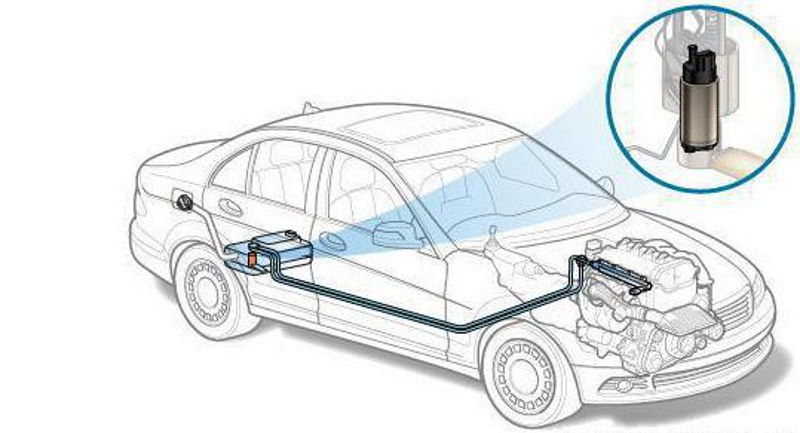
Fuel pump operation diagram
For carburetor engine pumps, the most common causes of unit failure were:
- stuck check valve;
- damaged membrane;
- worn stock.
For diesel engine pumps, the most common causes of failure were:
- worn plunger pair;
- stretched or broken belt.
For electric fuel pumps, the most common causes of stoppage are:
- oxidized or dirty contacts;
- wiring or relay problems;
- damaged winding.
In the field, it is quite difficult to determine the cause of the failure of this unit, but there are several signs that indicate specific defects. If a car equipped with an injection engine stalls on the go, then it starts up and drives on, then most likely the reason is dirty / oxidized contacts, as well as wiring or relays, due to which the pump does not always receive enough voltage and current to work. If the car equipped with a carburetor engine stalls and does not keep speed, but the carburetor is exactly in good order, then you can determine the problem with the help of an oil dipstick - if it smells of gasoline, then the membrane is torn, if not, then either the stem is worn off or the valve sinks.
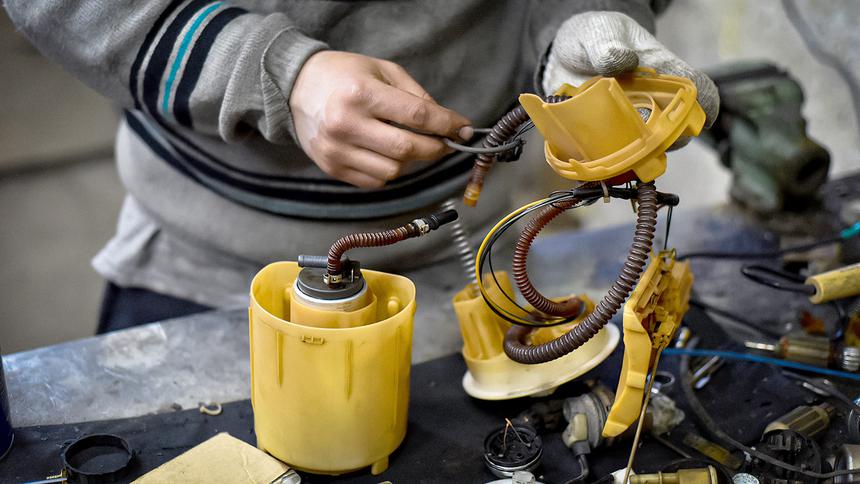
Defective fuel pump
Any malfunction of the fuel pump on cars with injection or diesel engines means a complete impossibility to move on, however, owners of carburetor cars can continue the trip even without replacing the unit. This will require a small oil-resistant container and a fuel hose. If you are the owner of a carburetor car and find yourself in such a situation, then proceed as follows:
- pour gasoline from the tank into an oil-resistant container;
- install it so that it is slightly higher than the carburetor;
- disconnect the supply hose from the pump and connect to this container;
- disconnect the return hose from the pipeline and plug it with a bolt or in any other convenient and reliable way.
Clogged fuel filter or kinked fuel line
If, while driving uphill or transporting cargo, the speed drops and the car stalls, and then it starts up and goes on without problems for some time, then the reason is most likely a clogged filter or a squeezed line. On carbureted and old injection cars, this effect is easy to eliminate, because the filter is located in the engine compartment or under the bottom, and replacing them will require a screwdriver or a pair of wrenches.
To change the filter on a car with a carburetor, proceed as follows:
- unscrew the clamps on both sides of the defective part;
- remember the direction of the arrow indicating the correct movement of the fuel;
- remove the hoses from the tips of the part;
- install a new filter;
- prime the fuel pump to fill the filter and carburetor.
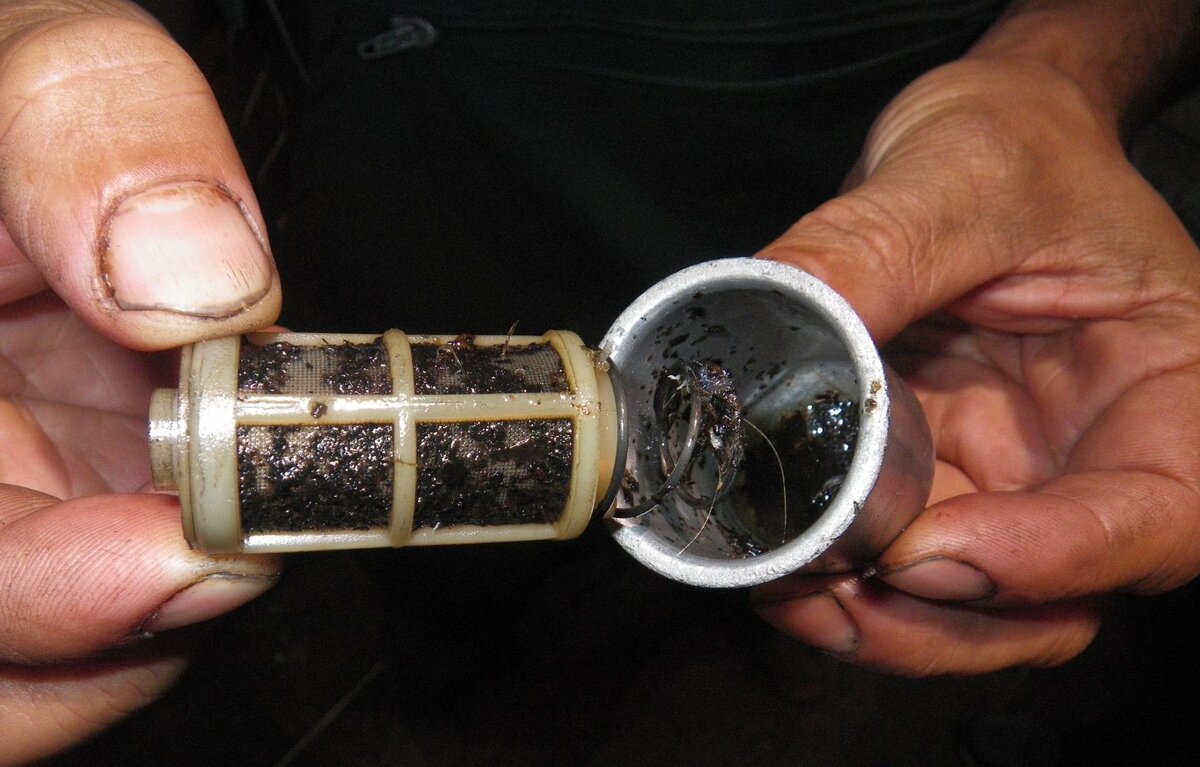
Clogged fuel filter
To replace the filter element on an injection machine, proceed as follows:
- put the car in neutral and handbrake;
- disconnect the fuel pump terminals;
- start the engine;
- wait until it stalls, having worked out all the fuel, this is necessary to reduce the pressure in the line and ramp;
- raise the rear of the car with a jack (this is only necessary if the filter is under the bottom);
- fix the body with supports, if there are none, remove the wheel from the raised side, and also remove the spare wheel from the trunk and place them under the body, if for some reason there is no spare wheel, then put the rear wheel under the brake disc or drum;
- lay a mat;
- get under the car;
- unscrew the filter nuts with wrenches, if it is fixed with clamps, then unscrew them with a screwdriver;
- remove the old filter and install the new filter;
- tighten nuts or clamps;
- reinstall the wheel;
- take the car off the jack.
Remember: the filter becomes clogged gradually. Therefore, having found the first signs or upon reaching the scheduled mileage (5-15 thousand km, depending on the quality of the fuel and the condition of the tank), replace it in the garage or contact a car service.
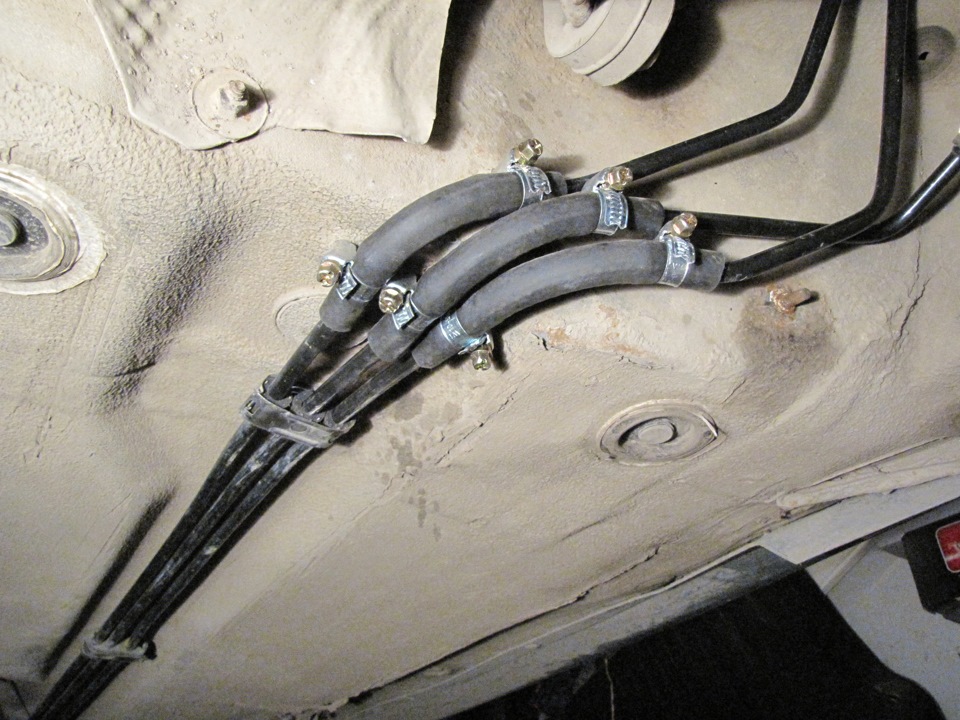
Fuel supply line
If replacing the filter did not help, the car still stalls on the go and after a while it starts up, then the fuel supply line (copper, aluminum or steel tube passing under the bottom of the car) is most likely damaged. If you have a pit or lift, as well as an extension cord with a bright lamp, then you can find the damaged tube yourself. If you do not have this equipment, as well as to replace the line, contact a car service.
Faulty wiring
Such a problem manifests itself as follows - the car suddenly turns off completely and does not respond to any actions, including turning the ignition key or manipulating the alarm key fob, and even the instrument panel does not light up. After some time, the machine suddenly comes to life on its own and works normally again until the next shutdown. If this happened to you, you should know that a hidden defect has appeared in the vehicle's electrical wiring, which appears only under certain conditions that you most likely do not know.

Car electrician
In carburetor machines, the wiring was simple, and contained a minimum of blocks and systems, however, the appearance of injection engines and a new element base led to a strong complication of the electrical part of the vehicle. New systems appeared, and existing ones began to perform previously unusual functions. One thing unites all these systems - they are powered by a battery (battery) and a generator. Here are the most common wiring faults that cause the car to stall on the move and then start:
- bad "earth";
- poor contact of the terminals with the legs of the battery;
- positive wire damaged;
- the contact group of the ignition switch is damaged;
- the charge voltage is not supplied from the generator;
- the contacts of the mounting block or the electronic engine control unit (ECU) are damaged.
All these defects have one thing in common - they appear unexpectedly, then disappear. This is due to the fact that even an oxidized terminal contact or a broken cable core transmit electricity, but if some conditions arise, their conductivity is disturbed, and not a single car system can work without electricity. Moreover, the condition leading to the appearance of such a problem can be anything from a certain temperature to vibration or an increased electric current.
Finding a problem requires deep knowledge in the field of auto electrics and extensive experience in performing such work, as well as various equipment, so we recommend that you immediately contact a good auto repair shop where there is an experienced electrician and diagnostician.
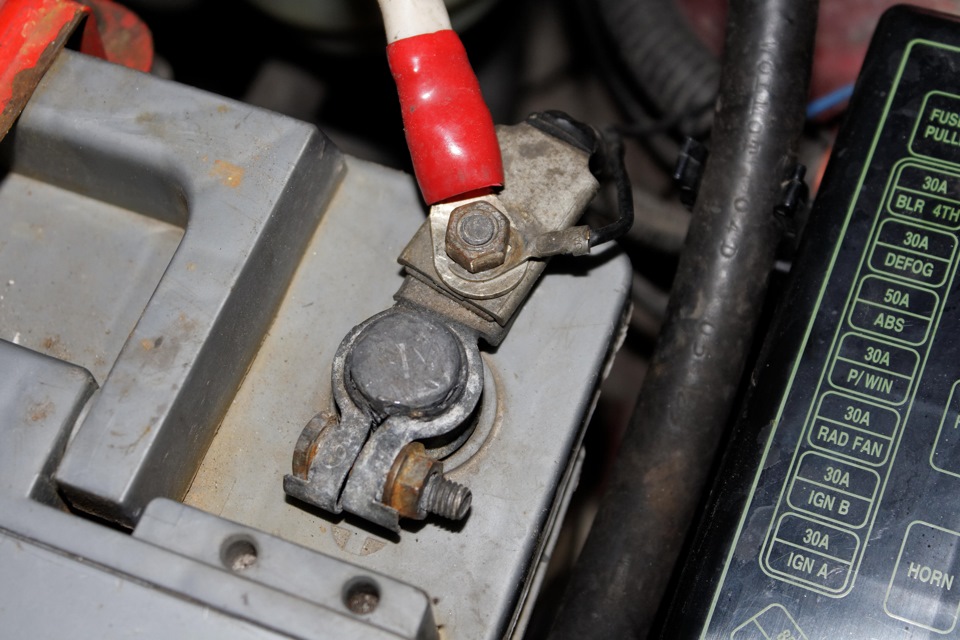
Battery terminal
The exception is poor adhesive contact with the battery legs, in this case it is enough to tighten the nuts, but if the legs are covered with a white coating, then clean all the contacts with sandpaper.
Defective ignition system
Despite the fact that the ignition system is part of the electrical equipment of the car, it is a separate "kingdom", because it is fed through wires not only low (12 volts) or signal, but also high (tens of kilovolts) voltage. In addition, this system consumes much less energy than a starter or headlights, and is also able to work even when the generator is not running and the battery is almost dead.
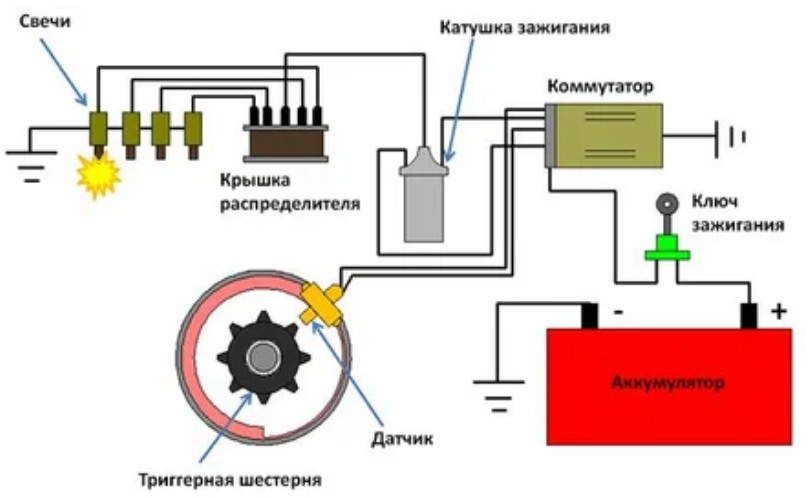
Vehicle ignition system
The principle of operation of the ignition system of injection and carburetor machines is the same - at the signal of the sensor (regardless of its type), a low voltage pulse is generated, which is fed through the wires to the ignition coil. After passing through the coil, the voltage of the pulse increases hundreds of times with the same current drop, then, through high-voltage wires, this pulse arrives at the spark plug and breaks through a thin layer of air between the electrodes, forming a spark. Diesel cars are deprived of this system, because the fuel in them ignites the hot air from high pressure.
If the car stalls on the move, then it starts, then the ignition system malfunction is associated with poor contact, which disappears from time to time, while all the main elements of the system are working. To check the ignition system, immediately after the engine stops spontaneously, try to start it for 20-30 seconds, and start the engine as usual. Even if it starts, immediately turn off and unscrew the candles - if at least one is wet, the problem is definitely in the ignition system.
Dry the spark plug with compressed air, or replace it with a new one, then screw it into the engine and start the engine, and shut it off after a minute. If all the spark plugs are dry, then a sudden defect in the ignition system is confirmed.
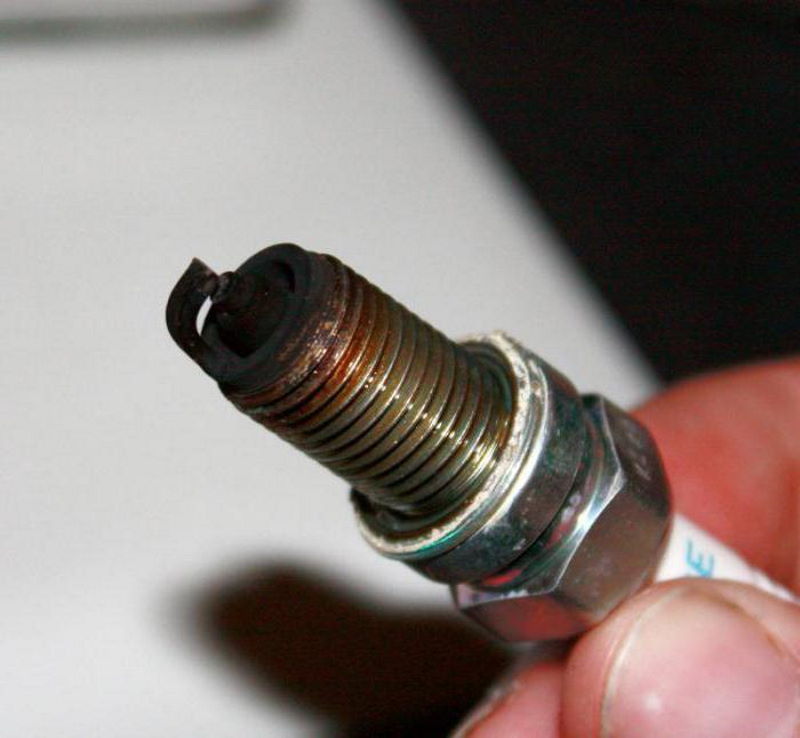
Spark plug
To find the reason for this behavior of the ignition system, carefully check all the wires and contacts related to it, perhaps some wire has broken and, from time to time, it stops transmitting electricity. It is also possible to short-circuit bare (with worn or damaged insulation) to ground or some other wires. Occasionally, the cause of such a defect is an oxidized or dirty terminal, which does not pass electric current well, so remove dirt or rust from them with any contact cleaner.
If it was not possible to fix the problem on your own, the car still stalls on the go, then it starts and drives on, and the reasons for this behavior have not been established, contact an auto electrician to fully check the ignition system.
Air-fuel mixture preparation system malfunctioning
Efficient operation of the engine is possible only when the ratio of fuel and air entering the cylinders corresponds to the operating mode of the power unit and the load on it. The stronger the deviation from the optimal ratio, and in any direction, the worse the engine functions, up to:
- unstable work;
- strong vibration;
- stop.
Carburetor
In carburetor engines, the ratio of fuel and gasoline in the mixture depends on the installed jets, so a serious change in this parameter without disassembling the carburetor is not provided. However, even on such cars, there are situations when the car stalls and does not keep speed, although no one has changed the carburetor jets.
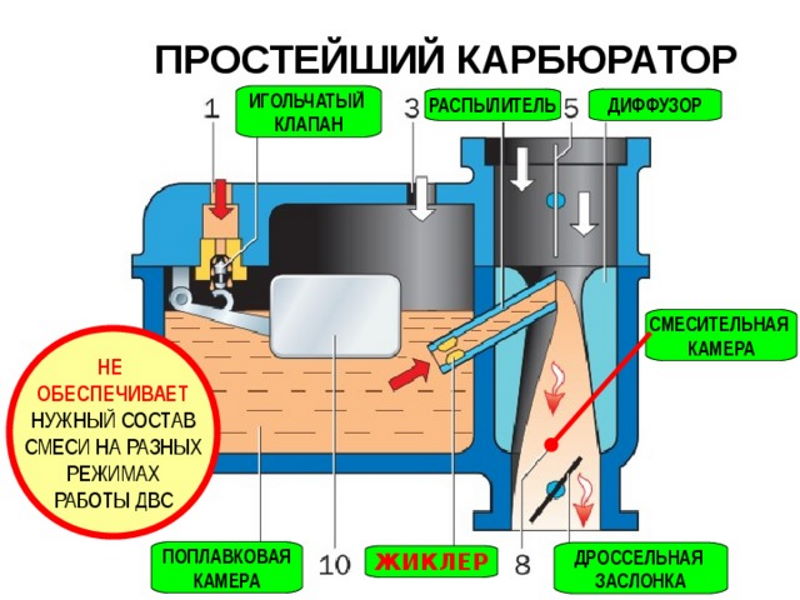
How the carburetor works
Here are the main reasons for this behavior:
- air leakage not provided for by the design;
- dirty air filter;
- clogging of the jets;
- incorrect fuel level in the float chamber.
The most common causes of air leakage are:
- deformation of the carburetor sole;
- loosening the nuts securing the carburetor;
- burnout of carburetor gaskets;
- damage to the hose, adapter, valve or membrane of the vacuum brake booster (VUT).
It is not difficult to determine air leakage - unstable, up to a stop, idle speed speaks about it, which even out after pulling out the suction handle. To eliminate suction, it is enough:
- replace the carburetor gaskets (we recommend doing this even if the old ones look normal);
- tighten the nuts with the force specified in the manual (usually 1,3–1,6 kgf•m);
- replace the damaged hose;
- repair VUT.
To determine the condition of the air filter, remove the cover from it and inspect it, if it is not white or yellow, replace it. To check the carburetor for other malfunctions, as well as to eliminate them, contact an experienced minder, fueler or carburetor.

Air filter housing
You will find more detailed information about the malfunctions of carburetor engines and the reasons why they spontaneously stall here (why does a carburetor machine stall).
Injection
The formation of a mixture with an optimal ratio of fuel and air depends on the correct operation of:
- all sensors;
- ECU;
- fuel pump and rail pressure control valve;
- gas distribution mechanism;
- ignition systems;
- effective atomization of fuel by nozzles.
Most of these cars independently determine the incorrect operation of any element or system, after which the malfunction indicator lights up, which is called a “check” (from the English “Check engine”).
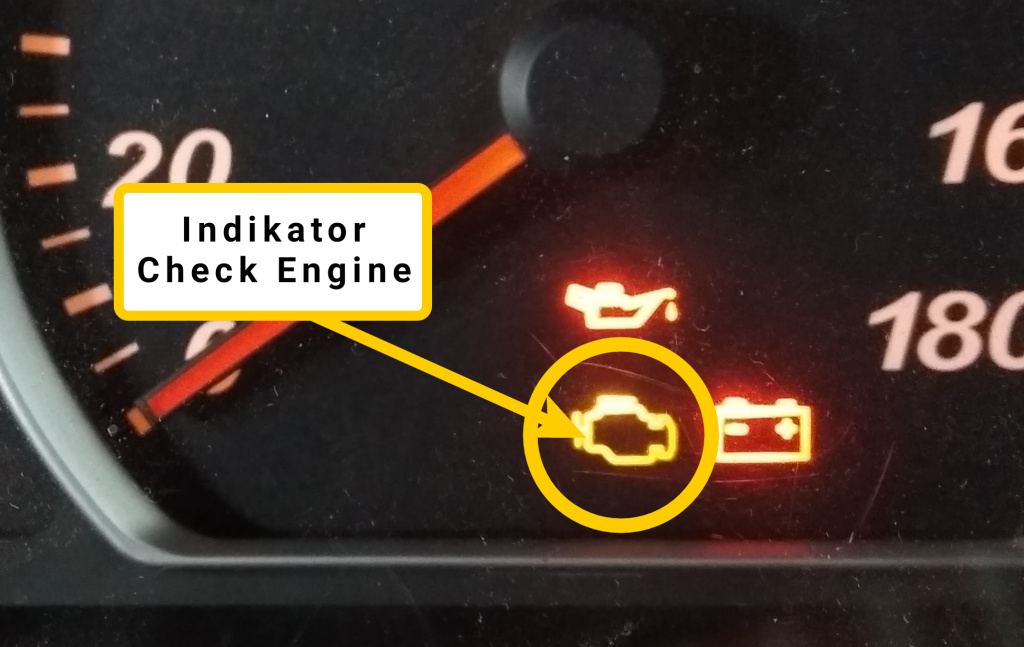
Engine malfunction indicator
However, for a more accurate diagnosis, you need a scanner (a laptop with the appropriate programs and an adapter cable is suitable) and experience, so we recommend contacting a computer diagnostics specialist.
Mechanical damage to the engine
Mechanical damage or malfunctions of the power unit include:
- incorrect valve clearance;
- jumped timing belt or timing chain;
- low compression.
Incorrect valve clearance
After starting the engine, the valves, like the rest of the elements of the gas distribution mechanism, gradually heat up, and as the temperature rises, their physical dimensions increase, which means that the distance between the valve tappet and the camshaft cam is reduced. The gap between the cam and the pusher is called the valve clearance, and for the normal operation of the power unit, the size of this gap must be maintained with an accuracy of five hundredths of a millimeter.
Its increase will lead to incomplete opening of the valves, that is, the cylinders will be filled with less air or mixture, and its decrease will lead to incomplete closing of the valves after the engine warms up. In this case, not only will the compression drop, but part of the mixture will burn out inside the cylinder head, which will lead to overheating and a quick breakdown of the engine.

Engine valve clearances
Most often, this problem occurs on carbureted engines and injection engines that are not equipped with hydraulic lifters. The main signs of an incorrect clearance are:
- a noticeable decrease in engine power;
- strong heating of the power unit;
- unstable idling, up to a stop.
A strong increase in the gap is possible only as a result of improper repair of the cylinder head or adjustment of the valve mechanism, in order to eliminate such a defect, contact any experienced minder or auto mechanic.
Jumped timing belt or timing chain
The timing is formed by two or more (depending on the type and design of the engine) shafts, one of which (crankshaft) is connected through connecting rods to all pistons, and the rest (distribution) actuate the valve mechanism. Thanks to gears and a belt or chain, the rotation of all shafts is synchronized and the crankshaft makes exactly two revolutions in one revolution of the camshaft. Camshaft cams are placed so that the valves open and close when the corresponding pistons reach certain points. Thus, the gas distribution cycle is carried out.
If the belt / chain is not sufficiently tensioned (including stretched), or oil runs from under the shaft seals, then when the gas is pressed sharply or the engine is braked urgently, it can jump one or more teeth, which will disrupt the entire gas distribution cycle. As a result, the engine loses power dramatically, and often stalls at idle or low speeds. Another extremely unpleasant consequence of jumping the target or the shaft can be the bending of the valves, this is due to the fact that they open at the wrong time and crash into the rising cylinder.
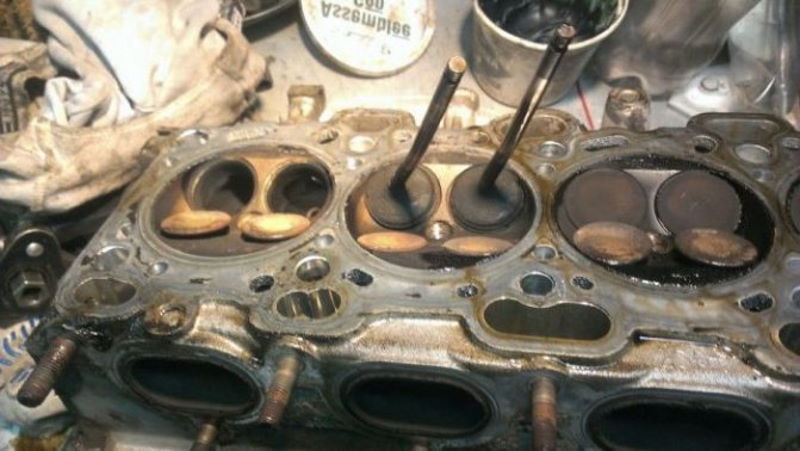
Bent valves
If the valves are not bent, then it is enough to correctly install the belt or chain (provided that they have been changed recently) or put in new ones, as well as check and, if necessary, repair the tension assembly. To avoid a jump:
- monitor the condition of the belt and chain, changing them a little earlier than required by the regulations;
- check and timely repair the tension system;
- check the condition of the seals of all shafts and replace them even if there is a slight leakage.
Perform these checks every time your vehicle is serviced, whether it's an oil change or scheduled maintenance.
Low compression
Compression - that is, the pressure in the combustion chamber when the piston reaches top dead center - depends on many parameters, but the main thing is the condition of the engine. The lower the compression, the worse the motor functions, up to unstable operation or spontaneous stop. The most common causes of low compression are:
- burnout of valves or pistons;
- wear or damage to piston rings;
- breakdown of the cylinder head gasket;
- loosening cylinder head bolts.

Compressometer
The only way to determine low compression is to measure it with a compression gauge, and the permissible minimum values \uXNUMXb\uXNUMXbat which the engine still functions normally depend on the type of fuel on which the engine must run:
- AI-76 8 atm;
- AI-92 10 atm;
- AI-95 12 atm;
- AI-98 13 atm;
- diesel 25 atm.
Remember: this is the lower compression threshold, after which the stable operation of the motor is disturbed, but for the efficient functioning of the unit, the indicators should be 2–5 units higher. Determining the cause of low compression requires deep knowledge and extensive experience, so we recommend that you contact a minder or mechanic with a good reputation for diagnosis.
Driver errors
If the vehicle is fully functional, but the car still stalls on the go, no matter if it is a diesel or gasoline engine, the reasons are always related to the behavior of the driver. The efficiency of an automobile motor primarily depends on the speed, the greatest efficiency is achieved between the peaks of torque and power (an average of 3,5–5 thousand rpm for gasoline and 2–4 thousand for diesel engines). If the vehicle is moving uphill, and even loaded, and the driver has chosen the wrong gear, due to which the speed is lower than optimal, then there is a high chance that the engine will stall, unable to cope with the load.

Optimal engine speed
Another reason is the incorrect operation of the gas and clutch pedals during the start of movement, if the driver does not press the gas enough, but at the same time abruptly releases the clutch, the power unit will stall.
How to avoid such situations
So that the car never lets you down, remember the main rule - if the driver drives the car correctly, the car stalls on the go due to some kind of malfunction that appeared earlier, but for some reason has not shown itself yet. Therefore, do not neglect maintenance and at the first sign of a malfunction, immediately diagnose and fix the problem. If you can’t figure out on your own why the car stalls on the go, contact a car service with a good reputation, they will quickly determine the cause and make the necessary repairs.
In addition, we recommend that you carefully read the following articles:
- the car stalls when hot;
- The car starts and immediately stalls when cold - what could be the reasons;
- Why the car twitches, troit and stalls - the most common causes;
- When you press the gas pedal, the car with the injector stalls - what are the causes of the problem.
In them you will find a lot of useful information and recommendations that will help you operate your vehicle correctly and safely.
Conclusion
Sudden shutdown of the machine's engine while driving is a serious hazard and may cause an accident. To avoid such a development of events, carefully monitor the technical condition of your vehicle and learn how to drive it correctly. If the problem has already arisen, try to immediately determine its cause, and then carry out the necessary repairs.